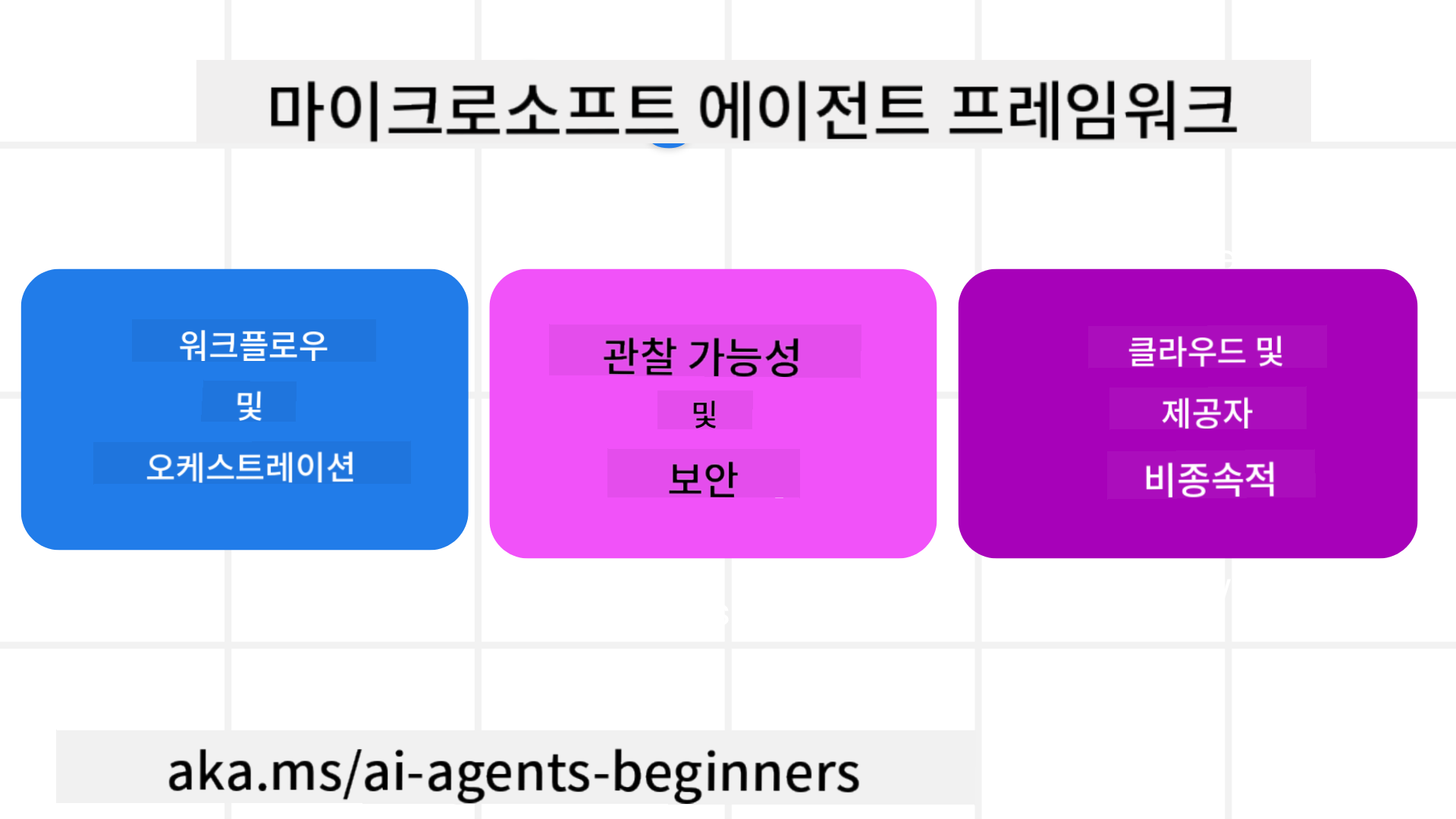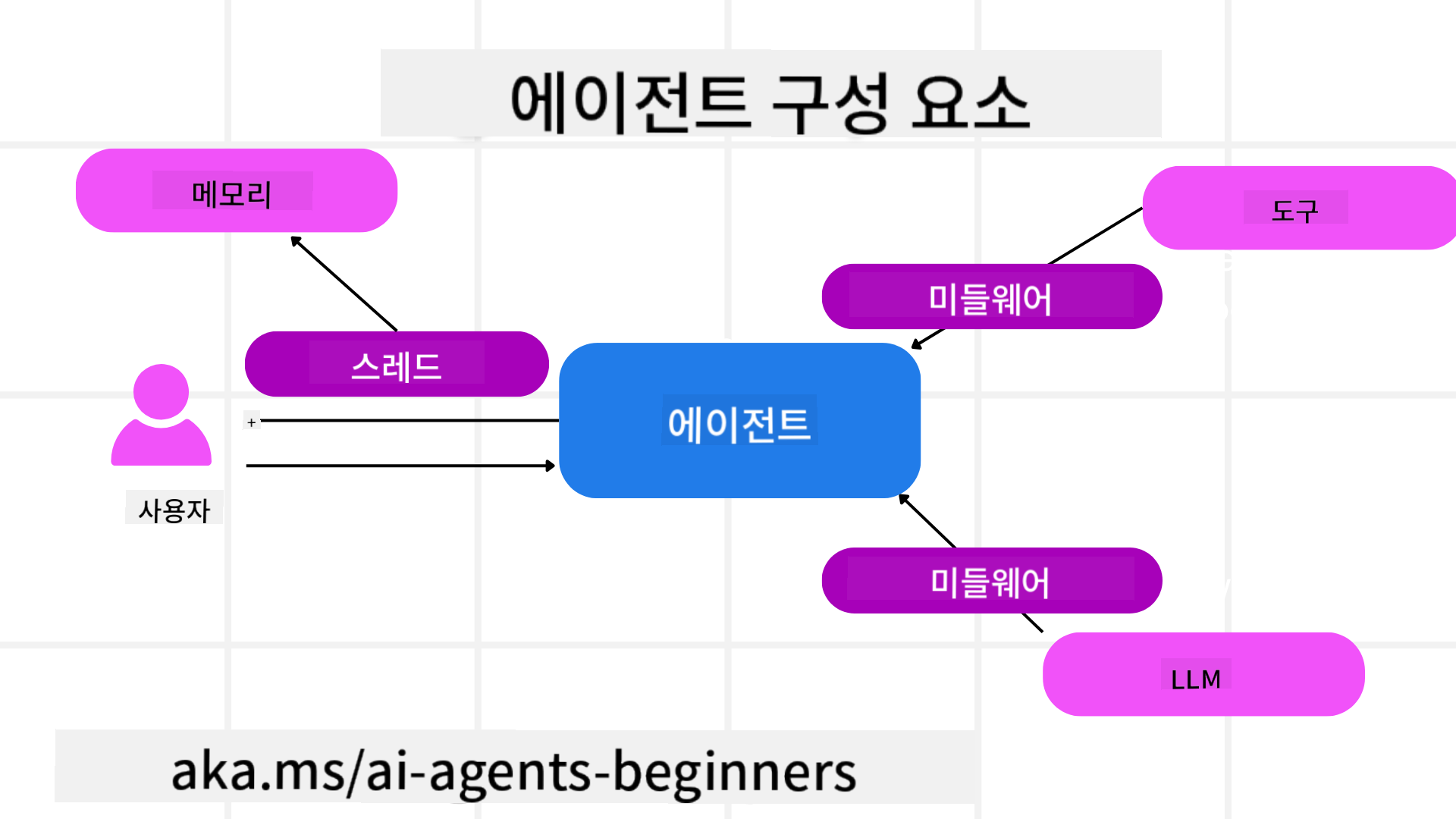ai-agents-for-beginners
Microsoft Agent Framework 탐구하기

소개
이 강의에서는 다음 내용을 다룹니다:
- Microsoft Agent Framework 이해하기: 주요 기능과 가치
- Microsoft Agent Framework의 핵심 개념 탐구
- MAF와 Semantic Kernel 및 AutoGen 비교: 마이그레이션 가이드
학습 목표
이 강의를 완료한 후, 다음을 할 수 있습니다:
- Microsoft Agent Framework를 사용하여 프로덕션 준비된 AI 에이전트 구축
- Microsoft Agent Framework의 핵심 기능을 에이전트 기반 사용 사례에 적용
- 기존 에이전트 기반 프레임워크와 도구를 마이그레이션 및 통합
코드 샘플
Microsoft Agent Framework (MAF)의 코드 샘플은 이 저장소의 xx-python-agent-framework 및 xx-dotnet-agent-framework 파일에서 찾을 수 있습니다.
Microsoft Agent Framework 이해하기

Microsoft Agent Framework (MAF)는 Semantic Kernel과 AutoGen에서 얻은 경험과 학습을 기반으로 구축되었습니다. 이는 프로덕션 및 연구 환경에서 다양한 에이전트 기반 사용 사례를 처리할 수 있는 유연성을 제공합니다. 주요 시나리오는 다음과 같습니다:
- 순차적 에이전트 오케스트레이션: 단계별 워크플로가 필요한 경우.
- 동시 오케스트레이션: 에이전트가 동시에 작업을 완료해야 하는 경우.
- 그룹 채팅 오케스트레이션: 에이전트가 하나의 작업을 협력하여 수행하는 경우.
- 핸드오프 오케스트레이션: 에이전트가 하위 작업을 완료하면서 작업을 서로 넘기는 경우.
- 마그네틱 오케스트레이션: 관리자 에이전트가 작업 목록을 생성 및 수정하고 하위 에이전트를 조정하여 작업을 완료하는 경우.
프로덕션에서 AI 에이전트를 제공하기 위해 MAF는 다음과 같은 기능을 포함합니다:
- 관측 가능성: OpenTelemetry를 사용하여 AI 에이전트의 모든 작업(도구 호출, 오케스트레이션 단계, 추론 흐름 및 Azure AI Foundry 대시보드를 통한 성능 모니터링)을 추적.
- 보안: Azure AI Foundry에서 에이전트를 네이티브로 호스팅하여 역할 기반 액세스, 개인 데이터 처리 및 내장된 콘텐츠 안전과 같은 보안 제어 포함.
- 내구성: 에이전트 스레드와 워크플로가 일시 중지, 재개 및 오류에서 복구 가능하여 장기 실행 프로세스 지원.
- 제어: 인간이 승인해야 하는 작업을 표시하는 인간 개입 워크플로 지원.
Microsoft Agent Framework는 상호 운용성을 중점적으로 다음을 제공합니다:
- 클라우드 독립성: 에이전트는 컨테이너, 온프레미스 및 여러 클라우드에서 실행 가능.
- 프로바이더 독립성: Azure OpenAI 및 OpenAI를 포함한 선호하는 SDK를 통해 에이전트 생성 가능.
- 오픈 표준 통합: Agent-to-Agent(A2A) 및 Model Context Protocol(MCP)과 같은 프로토콜을 사용하여 다른 에이전트 및 도구를 발견하고 활용 가능.
- 플러그인 및 커넥터: Microsoft Fabric, SharePoint, Pinecone 및 Qdrant과 같은 데이터 및 메모리 서비스에 연결 가능.
이제 Microsoft Agent Framework의 핵심 개념에 이러한 기능이 어떻게 적용되는지 살펴보겠습니다.
Microsoft Agent Framework의 핵심 개념
에이전트

에이전트 생성
에이전트 생성은 추론 서비스(LLM Provider), AI 에이전트가 따를 지침 세트, 그리고 할당된 name을 정의하여 이루어집니다:
agent = AzureOpenAIChatClient(credential=AzureCliCredential()).create_agent( instructions="You are good at recommending trips to customers based on their preferences.", name="TripRecommender" )
위 코드는 Azure OpenAI를 사용하고 있지만, 에이전트는 Azure AI Foundry Agent Service를 포함한 다양한 서비스를 사용하여 생성할 수 있습니다:
AzureAIAgentClient(async_credential=credential).create_agent( name="HelperAgent", instructions="You are a helpful assistant." ) as agent
OpenAI Responses, ChatCompletion API
agent = OpenAIResponsesClient().create_agent( name="WeatherBot", instructions="You are a helpful weather assistant.", )
agent = OpenAIChatClient().create_agent( name="HelpfulAssistant", instructions="You are a helpful assistant.", )
또는 A2A 프로토콜을 사용하는 원격 에이전트:
agent = A2AAgent( name=agent_card.name, description=agent_card.description, agent_card=agent_card, url="https://your-a2a-agent-host" )
에이전트 실행
에이전트는 .run 또는 .run_stream 메서드를 사용하여 비스트리밍 또는 스트리밍 응답을 실행합니다.
result = await agent.run("What are good places to visit in Amsterdam?")
print(result.text)
async for update in agent.run_stream("What are the good places to visit in Amsterdam?"):
if update.text:
print(update.text, end="", flush=True)
각 에이전트 실행은 max_tokens, 에이전트가 호출할 수 있는 tools, 심지어 에이전트에 사용되는 model과 같은 매개변수를 사용자 정의할 수 있는 옵션을 포함할 수 있습니다.
이는 특정 모델이나 도구가 사용자의 작업을 완료하는 데 필요한 경우에 유용합니다.
도구
도구는 에이전트를 정의할 때:
def get_attractions( location: Annotated[str, Field(description="The location to get the top tourist attractions for")], ) -> str: """Get the top tourist attractions for a given location.""" return f"The top attractions for {location} are."
# When creating a ChatAgent directly
agent = ChatAgent( chat_client=OpenAIChatClient(), instructions="You are a helpful assistant", tools=[get_attractions]
그리고 에이전트를 실행할 때 정의할 수 있습니다:
result1 = await agent.run( "What's the best place to visit in Seattle?", tools=[get_attractions] # Tool provided for this run only )
에이전트 스레드
에이전트 스레드는 다중 턴 대화를 처리하는 데 사용됩니다. 스레드는 다음 방법으로 생성할 수 있습니다:
get_new_thread()를 사용하여 스레드를 시간이 지나도 저장 가능.- 에이전트를 실행할 때 자동으로 스레드를 생성하고 현재 실행 동안만 스레드 유지.
스레드를 생성하려면 코드는 다음과 같습니다:
# Create a new thread.
thread = agent.get_new_thread() # Run the agent with the thread.
response = await agent.run("Hello, I am here to help you book travel. Where would you like to go?", thread=thread)
그런 다음 스레드를 직렬화하여 나중에 사용할 수 있도록 저장할 수 있습니다:
# Create a new thread.
thread = agent.get_new_thread()
# Run the agent with the thread.
response = await agent.run("Hello, how are you?", thread=thread)
# Serialize the thread for storage.
serialized_thread = await thread.serialize()
# Deserialize the thread state after loading from storage.
resumed_thread = await agent.deserialize_thread(serialized_thread)
에이전트 미들웨어
에이전트는 도구와 LLM과 상호작용하여 사용자의 작업을 완료합니다. 특정 시나리오에서는 이러한 상호작용 사이에서 작업을 실행하거나 추적하고 싶을 수 있습니다. 에이전트 미들웨어는 이를 가능하게 합니다:
Function Middleware
이 미들웨어는 에이전트와 호출할 함수/도구 사이에서 작업을 실행할 수 있도록 합니다. 예를 들어 함수 호출에 대한 로깅을 수행하고 싶을 때 사용됩니다.
아래 코드에서 next는 다음 미들웨어 또는 실제 함수를 호출할지 정의합니다.
async def logging_function_middleware(
context: FunctionInvocationContext,
next: Callable[[FunctionInvocationContext], Awaitable[None]],
) -> None:
"""Function middleware that logs function execution."""
# Pre-processing: Log before function execution
print(f"[Function] Calling {context.function.name}")
# Continue to next middleware or function execution
await next(context)
# Post-processing: Log after function execution
print(f"[Function] {context.function.name} completed")
Chat Middleware
이 미들웨어는 에이전트와 LLM 간 요청 사이에서 작업을 실행하거나 로깅할 수 있도록 합니다.
여기에는 AI 서비스에 전송되는 messages와 같은 중요한 정보가 포함됩니다.
async def logging_chat_middleware(
context: ChatContext,
next: Callable[[ChatContext], Awaitable[None]],
) -> None:
"""Chat middleware that logs AI interactions."""
# Pre-processing: Log before AI call
print(f"[Chat] Sending {len(context.messages)} messages to AI")
# Continue to next middleware or AI service
await next(context)
# Post-processing: Log after AI response
print("[Chat] AI response received")
에이전트 메모리
Agentic Memory 강의에서 다룬 바와 같이, 메모리는 에이전트가 다양한 컨텍스트에서 작동할 수 있도록 하는 중요한 요소입니다. MAF는 여러 유형의 메모리를 제공합니다:
인메모리 저장소
애플리케이션 런타임 동안 스레드에 저장된 메모리입니다.
# Create a new thread.
thread = agent.get_new_thread() # Run the agent with the thread.
response = await agent.run("Hello, I am here to help you book travel. Where would you like to go?", thread=thread)
영구 메시지
다른 세션 간 대화 기록을 저장할 때 사용되는 메모리입니다. chat_message_store_factory를 사용하여 정의됩니다:
from agent_framework import ChatMessageStore
# Create a custom message store
def create_message_store():
return ChatMessageStore()
agent = ChatAgent(
chat_client=OpenAIChatClient(),
instructions="You are a Travel assistant.",
chat_message_store_factory=create_message_store
)
동적 메모리
에이전트를 실행하기 전에 컨텍스트에 추가되는 메모리입니다. 이러한 메모리는 mem0과 같은 외부 서비스에 저장될 수 있습니다:
from agent_framework.mem0 import Mem0Provider
# Using Mem0 for advanced memory capabilities
memory_provider = Mem0Provider(
api_key="your-mem0-api-key",
user_id="user_123",
application_id="my_app"
)
agent = ChatAgent(
chat_client=OpenAIChatClient(),
instructions="You are a helpful assistant with memory.",
context_providers=memory_provider
)
에이전트 관측 가능성
관측 가능성은 신뢰할 수 있고 유지 관리 가능한 에이전트 기반 시스템을 구축하는 데 중요합니다. MAF는 OpenTelemetry와 통합하여 추적 및 미터를 제공하여 관측 가능성을 향상시킵니다.
from agent_framework.observability import get_tracer, get_meter
tracer = get_tracer()
meter = get_meter()
with tracer.start_as_current_span("my_custom_span"):
# do something
pass
counter = meter.create_counter("my_custom_counter")
counter.add(1, {"key": "value"})
워크플로
MAF는 작업을 완료하기 위한 사전 정의된 단계를 제공하며, 이러한 단계에서 AI 에이전트를 구성 요소로 포함합니다.
워크플로는 더 나은 제어 흐름을 가능하게 하는 다양한 구성 요소로 구성됩니다. 워크플로는 다중 에이전트 오케스트레이션 및 체크포인트를 통해 워크플로 상태를 저장할 수 있습니다.
워크플로의 핵심 구성 요소는 다음과 같습니다:
실행자
실행자는 입력 메시지를 받고, 할당된 작업을 수행한 후 출력 메시지를 생성합니다. 이는 워크플로를 더 큰 작업 완료로 진행시킵니다. 실행자는 AI 에이전트 또는 사용자 정의 로직일 수 있습니다.
엣지
엣지는 워크플로에서 메시지의 흐름을 정의하는 데 사용됩니다. 다음과 같은 유형이 있습니다:
직접 엣지 - 실행자 간 단순한 일대일 연결:
from agent_framework import WorkflowBuilder
builder = WorkflowBuilder()
builder.add_edge(source_executor, target_executor)
builder.set_start_executor(source_executor)
workflow = builder.build()
조건부 엣지 - 특정 조건이 충족된 후 활성화됩니다. 예를 들어, 호텔 객실이 없을 때 실행자가 다른 옵션을 제안할 수 있습니다.
스위치-케이스 엣지 - 정의된 조건에 따라 메시지를 다른 실행자로 라우팅합니다. 예를 들어, 여행 고객이 우선 접근 권한을 가지고 있을 경우 다른 워크플로를 통해 작업이 처리됩니다.
팬아웃 엣지 - 하나의 메시지를 여러 대상에 전송.
팬인 엣지 - 여러 실행자로부터 여러 메시지를 수집하여 하나의 대상에 전송.
이벤트
워크플로에 대한 더 나은 관측 가능성을 제공하기 위해 MAF는 실행에 대한 내장 이벤트를 제공합니다:
WorkflowStartedEvent- 워크플로 실행 시작WorkflowOutputEvent- 워크플로가 출력 생성WorkflowErrorEvent- 워크플로에서 오류 발생ExecutorInvokeEvent- 실행자가 처리 시작ExecutorCompleteEvent- 실행자가 처리 완료RequestInfoEvent- 요청 발행
다른 프레임워크(Semantic Kernel 및 AutoGen)에서 마이그레이션
MAF와 Semantic Kernel의 차이점
간소화된 에이전트 생성
Semantic Kernel은 에이전트마다 Kernel 인스턴스를 생성해야 합니다. MAF는 주요 프로바이더에 대한 확장을 사용하여 간소화된 접근 방식을 제공합니다.
agent = AzureOpenAIChatClient(credential=AzureCliCredential()).create_agent( instructions="You are good at reccomending trips to customers based on their preferences.", name="TripRecommender" )
에이전트 스레드 생성
Semantic Kernel은 스레드를 수동으로 생성해야 합니다. MAF에서는 에이전트에 직접 스레드가 할당됩니다.
thread = agent.get_new_thread() # Run the agent with the thread.
도구 등록
Semantic Kernel에서는 도구가 Kernel에 등록되고 Kernel이 에이전트에 전달됩니다. MAF에서는 도구가 에이전트 생성 과정에서 직접 등록됩니다.
agent = ChatAgent( chat_client=OpenAIChatClient(), instructions="You are a helpful assistant", tools=[get_attractions]
MAF와 AutoGen의 차이점
팀 vs 워크플로
AutoGen에서는 에이전트의 이벤트 기반 활동을 위한 구조로 Teams를 사용합니다. MAF는 데이터를 실행자에게 그래프 기반 아키텍처를 통해 라우팅하는 Workflows를 사용합니다.
도구 생성
AutoGen은 에이전트가 호출할 함수를 래핑하기 위해 FunctionTool을 사용합니다. MAF는 @ai_function을 사용하며, 이는 유사하게 작동하지만 각 함수에 대한 스키마를 자동으로 추론합니다.
에이전트 동작
AutoGen에서는 기본적으로 에이전트가 단일 턴 에이전트이며, max_tool_iterations을 더 높게 설정해야 다중 턴이 가능합니다. MAF에서는 ChatAgent가 기본적으로 다중 턴으로 설정되어 있어 사용자의 작업이 완료될 때까지 도구를 계속 호출합니다.
코드 샘플
Microsoft Agent Framework의 코드 샘플은 이 저장소의 xx-python-agent-framework 및 xx-dotnet-agent-framework 파일에서 찾을 수 있습니다.
Microsoft Agent Framework에 대해 더 궁금한 점이 있으신가요?
Azure AI Foundry Discord에 참여하여 다른 학습자들과 만나고, 오피스 아워에 참석하며, AI 에이전트에 대한 질문에 답변을 받을 수 있습니다.
면책 조항:
이 문서는 AI 번역 서비스 Co-op Translator를 사용하여 번역되었습니다. 정확성을 위해 최선을 다하고 있으나, 자동 번역에는 오류나 부정확성이 포함될 수 있습니다. 원본 문서의 원어 버전을 권위 있는 자료로 간주해야 합니다. 중요한 정보의 경우, 전문적인 인간 번역을 권장합니다. 이 번역 사용으로 인해 발생하는 오해나 잘못된 해석에 대해 당사는 책임을 지지 않습니다.